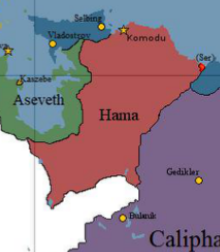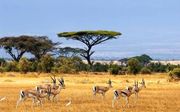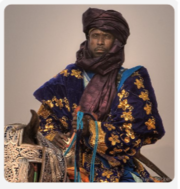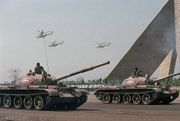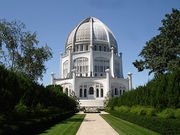Hamanian Empire
| Kingdom of Hama | ||||||
|---|---|---|---|---|---|---|
|
||||||
| Motto: Tahia imbraturia (Long live the empire) | ||||||
| Anthem: Allahu baraka imbraturia (God bless the empire) | ||||||
| Capital | Komodu | |||||
| Official languages | Hamanese language | |||||
| Recognised regional languages | Avanian, Laiatanese and giant speak | |||||
| Ethnic groups | Hamanite, Avanians, giants and lupines | |||||
| Demonym | Hamanian | |||||
| Government | Absolute monarchy with limited devolution | |||||
| - | King | Maduallahu | ||||
| - | Prime Minister | Mohamed Rashid | ||||
| Legislature | Consultative Assembly | |||||
| Establishment | ||||||
| - | Unification of Wawa, Kahiru and Giza | 1100 | ||||
| - | Islamic Invasion of Hama | 1300 | ||||
| - | Independence from the Islamic Empire | 1400 | ||||
| - | Invasion of Borea | 1600 | ||||
| - | Invasion of Itur | 1700 | ||||
| Area | ||||||
| - | Total | 3,000,000 km2 1,158,306 sq mi |
||||
| Population | ||||||
| - | estimate | 70,000,000 | ||||
| - | Density | 23/km2 59.6/sq mi |
||||
| GDP (nominal) | estimate | |||||
| - | Total | 1,26 trillion KRB | ||||
| - | Per capita | 18,000 KRB | ||||
| Gini | 40 medium |
|||||
| Currency | dahab (DHB) |
|||||
| Date format | DD/MM/YYYY | |||||
| Drives on the | the left | |||||
| ISO 3166 code | HMA | |||||
| Internet TLD | .hm | |||||
The Hamanian Empire is a sovereign state comprised of territory in Yasteria, Borea and Itur. The country has a large area covering almost 3 million square kilometres. It is formed of the Kingdom of Hama (Yasterian Hama), the Principality of Avania (Borean Hama) and Lupania. The country has a variety of landscapes such as semi arid regions with succulent vegetation, or dry grassland, temperate rain deciduous forests, cold steppes, mountainous regions with an Alpine climate. The nation has a wide variety of animals and plants, some which are endemic to the environments in which they are found. In some areas animals and plants are threatened by habitat destruction, climate change and poaching, but there are programs to preserve this wildlife. The empire has a coastline that spans over two major waterways: the Borean Sea and Gulf of Itur.
It is believed that human nomads migrated to the Yasterian portion of the empire around 1,000 years BCE. They travelled in large groups called caravans with strong hierarchies and distinct identities, competing with one another for access to water, pasture and the migrating herds. Around 500 years BCE, the first settlements began to be built with a leader. They engaged in trade with other settlements and sometimes engaged in war over oases and trade routes. The first major city ever built was Komodu around 200 CE and began sending mariners to trade goods across other lands around 500 CE. The city was invaded around 700 CE, but the impact of its civilisation on the art and science of the rest of the Hamanite people was substantial. Around 1,000 CE, the original city of Komodu fell and the Kingdoms of Kahiru in the south, Wawa along the coast, and Giza in the east were established. They engaged in constant wars and changing alliances over territory and resources. Around 1,100 CE the Kingdoms of Wawa was invaded by the Kingdom of Kahiru and Giza was subjugated under King Hama I. Around 1,300 CE, the Kingdoms of the Hamanites were invaded by the Islamic Empire. Their pagan religions were supplanted and replaced with Islam. Around 1,400 CE, the rule of the Islamic Empire was driven out and the Kingdom of Hama was formed. The Hamanite sect, the Abrahamic sect evolved into a fully fledged religion under the rule of King Bamu around 1,500 CE. Around 1,600 CE, the Hamanians invaded and settled eastern Borea, displacing and assimilating the native population. Around 1,700 CE, the Hamanians invaded southern Itur and fought against an alliance of Lupine nations led by Laiatan.
The empire is an absolute empire under the King of Hama. The King relies on the extensive technocratic bureaucracy and complicity of subnational rulers to enforce the law and keep the empire unified. Although the King has the power to issue decrees, local customs and statutes have the force of law in many jurisdictions which have significant autonomy. The Hamanian Empire retains diplomatic and economic relations with many nations of northern Yasteria, Itur and Borea. The country has a large military, particularly a large navy that protects it from attack and maintains the rigid hand of its rulers. The Hamanite people from the majority ethnic group, having spread throughout the empire, with the Hamanese language forming the lingua franca and the language of the government. There are various minority groups such as lupines, giants, and ursines who maintain limited areas of autonomy over some of their native lands. The majority religion is Abrahamism but there are some people who practice Islam, who belong to the Mahitou religion and other folk beliefs. The empire has a population of approximately 70 million people spread over three timezones.
The nation has an economic output of 1,26 trillion kiribs and an average income of 18,000 kiribs per person. The nation has strong science and technology. The country has a well developed infrastructure and cities whose people enjoy similar lifestyles to the people of Aurora. The rural areas are underserved and some areas are inaccessible. The nation has a diverse range of energy sources, but electricity has not been delivered to all citizens. The empire has a substantial intelligentsia and mercantile class who enjoy limited influence, but the landed aristocrats retain statutory advantages and control vast natural resources. The nation suffers from inequality, unemployment is fairly high and poverty is rampant among minorities, and some laws place people in virtual servitude, but the country is a net lender, a major exporter and has substantial reserves of gold that back its currency, the dahab.
Contents
Geography
The empire has an area of almost 3 million square kilometres, comprised of territory in three continents that form Yasteria Major. The country has a diverse range of wildlife and plants, some of which are endemic to the habitats in which they are found. The country also has significant mineralogical diversity due to substantial differences in the geographic evolution of those nations. There are substantial environmental challenges. Some areas have active civil, business and government support that has preserved the local environment, while some areas suffer from deforestation (to clear land for urban development, agriculture and mining), eutrophication from excessive chemical use in farming (such as pesticides and fertilizers), and other general problems such as climate change that broadly affect other nations. The country is generally free of natural disasters but there have been landslides and flooding from deforested mountains and poor drainage in urban areas.
Yasterian Hama is primarily comprised of four biomes. The first is Savannah, which mainly receives rain in the rainy season which lasts for about six months generally over 40mm a day. The savannah has well developed vegetation such as shrubs and trees. The second biome is grassland which covers the center of the nation over a relatively smooth landscape that is largely flat except for a few hills. The area generally has three seasons. In the first season, there is frost and is known for gale force winds. The second is rainy while hail can occur, with precipitation of between 10 and 40mm per day. The third season is dry and hot. The eastern area is comprised of mountains that form most of the boundary between Yasterian Hama and Packilvania. Some of the mountains have glacial caps that feed the main rivers. The of which is the Bahadun River, that empties in the northern coast with several major tributaries supplying water and providing drainage over much of the country.
Borean Hama is primarily comprised of of three biomes. The first is cold steppe. This is grassland that covers much of the west and center. The area has cold weather and has very short days for half the year. There is frost that covers the ground, although snow is rare. The area is fairly dry with precipitation over a few months with an average rainfall of 5 to 30mm a day. The third biome is formed of Alpine mountains that run through the north. The mountains have an average elevation of 2,000 to 3,000 feet. These mountains are often capped with snow. Temperatures hover around freezing point for much of the year. The area seldom sees wet rain. Few plants grow. There are substantial cave networks, with large underground rivers that feed channels that spread over much of the east and south. The southern area has temperate forests. Precipitation is fairly inconsistent although there is rain throughout the year. The forests are mainly deciduous, temperatures are generally pleasant between 15 and 30 degrees Celcius, peaking during the summer months. Trees lose their leaves in fall.
Biodiversity
As a whole, the Hamanian Empire is one of the most biodiverse nations in the world. Yasterian Hama, alone has thousands of species of animals. There are birds such as ostrich, guinea fowl, peafowl, buzzards, egrets, herons, cranes, shoebills, ibises, ospreys, vultures, eagles, hawks, and owls. There are herbivores such as eland (the largest antelope in the world), oryx (a large antelope with long straight horns), Sable antelope, wildebeest (one of the fastest antelopes), nyala, kudu (an antelope with the most pronounced curly horns), impala, springbok (as small gazelle that has the longest and highest jump of any antelope) and zebra (a wild cousin of the horse with black and white stripes). There are also elephants (the largest land animal), giraffes (the tallest land animal), rhino (a large mammal with a long horn on the about) and hippopotamus (a large semi aquatic mammal infamous for its aggression).
Yasterian Hama also has many predatory animals as well. There are hyenas (which are often mistaken for canines), lions (the third largest big cat characterised by a large mane on males and strong social behaviour), leopards (solitary cats with bright spots capable of climbing trees), cheetahs (the world's fastest land mammal), wild dogs, aardwolves (the only canine anteater in the world), aardvark (an anteater resembling a pig), warthogs (which are mainly herbivores but are known to not only scavenge but hunt small animals). There are reptiles such as crocodiles (large reptiles that have existed since the time of the dinosaurs), monitor lizards and various species of snake such as cobras, adders and mambas (some of the most venomous snakes in the world), and pythons (some of the largest constrictors on the planet). There are smaller mammals such as porcupines (with long sharp quills), pangolins (with large scales and can roll into a sphere), honey badgers (known to be immune to snake poison) and meerkats (a mongoose species that lives in large groups).
Borean Itur also has a melange of animals. There are birds such as oystercatchers, cranes (particularly sand cranes), water birds such as geese, ducks (such as Mallards and cormorants) and swans (such as the Trumper swan and the largest flying bird in the world: the mute swan), pheasants such as grouse, frigate birds, kites, crows, ravens and owls (such as Titos). There are mammals such as deer (there are massive herds of elk, red deer and reindeer a renowned work animal), smaller bison (cousin to one of the biggest buffalo species) and others. There are also predators such as wolves (such as the prolific grey wolf), bears (such as black bears), wild boar (aggressive and predatory animals), beavers (large semi aquatic rodents known for their construction of large dams), otters (also water mammals) and weasels (particularly the large store and the ermine known for its luxurious white coat).
Politics
The politics of the Hamanian Empire take place in the framework of a absolute monarchy with limited devolution. The King of Hama, presently Maduallahu, who acceded to the throne by primogeniture as the eldest son of the his father and predecessor King Mohammed III, is the head of the empire. He has the power to appoint the Council of Ministers. The Council of Ministers is formed of the Prime Minister, currently Mohamed Rashid who presides over meetings and oversees the executive branch, and Ministers of the Crown who oversee specific portfolios and develop policies. The civil service is mostly professional and open to all citizens and permanent residents according to merit. Various boards have relative autonomy over various areas such as law enforcement, transport, health, education and public works.
There is a Consultative Assembly that is formed of chambers for the common people (which is largely formed of wealthy landowners, academics, merchants and leaders of minorities) and the ruling class (comprised of senior officials in the military, nobility and elected leaders of devolved communities). The Consultative Assembly is convened in a joint session to hear an address on the state of the nation and plans of the government from the Prime Minister. It has various committees which submit recommendations to the government on a number of issues. It sometimes sits as a plenary to allow members the opportunity to voice the concerns and represent the interests of their constituents.
The judicial branch is part of the executive branch. It is formed of boards, tribunals and committees that receive complaints and resolve disputes and issue legal recommendations, some of which are enforced by royal decree given the status of the adjudicator and importance of the case. There is a modern code or system that guides the legal process and regulates the legal profession. The devolved authorities have modern courts that have competence over a wide range of issues while some disputes and crimes are judged by religious leaders, military tribunals, tribal authorities or aristocratic rulers. The judicial system maintains some protections against discrimination, but there are inconsistencies and systematic imbalances in the interpretation and enforcement of the law with the poor, women and minorities often at a disadvantage.
The country is comprised of various divisions with varying levels of devolution. There are tribal authorized or reserves with authority that allow indigenous minority groups to have some control over their affairs, ruled through their traditions and customs. There are governates which are governed by agents of the central government. There are fiefs which are territories bequeathed to aristocratic families. As devolution is granted by royal decree, the jurisdiction of each division varies according to the context in which it was established. Areas ruled directly by the central government are often ruled by a technocratic bureaucracy and the government hopes to supplant other systems with this model.
Foreign relations
The foreign policy of the entire nation is shaped by the central government in Komodu. The Parliament is the only institution that has the power to pass treaties into law. Even if the King can sign a law on behalf of Hama and the broader Hamanian Empire indicating his commitment to that treaty, that treaty has no material effect or legal standing in any territory of the Hamanian Empire if it has not been approved by the Parliament into a law. Likewise, even if the King breaks an alliance with another nation or wants to back out of a treaty, he does not have the power to revoke it. Only Parliament can repeal a law or treaty. The King has the power to make peace and declare war, but without the financial and political backing of the Parliament, he will not be able to materially realize his commands.
The King can circumvent some aspects of these powers. He is able to make deals and negotiate with other nations. This gives him the power to direct the activities of the government with other nations. The Ministry of Foreign Affairs is responsible for administering and advising the King on foreign policy issues. The King appoints and dismisses ambassadors, recognizes foreign countries and receives the accreditation of foreign emissaries. The Ministry then oversees the Diplomatic Service on a daily basis. The Cabinet also has a role in advising the King on foreign policy issues. The Foreign Affairs Committee of the House of the People also makes recommendations on foreign policy issues.
Hama is part of the Northern Pact. The Northern Pact is an agreement signed by Laiatan, South Hills, Vekaiyu and Verdrassil. This agreement sets standards and frameworks by which cooperation on issues concerned with and use of the sea are structured and facilitated. This agreement builds on and draws from the Kerilo Accord and creates one of the first structured approaches to international cooperation on activity in the sea. The secretariat thereof is seated in Komodu. This organization was founded in 2018 by the initiative of the Minister of Foreign Affairs, Dajida Taru.
The nation has warm and courteous relations with Kuthernburg (with whom it had once competed for dominance over Borean and Iturian sea routes in the 17th and 18th century), the United Kingdom (the largest Abrahamist majority state in the world), Stratarin, Furnifold, Free Syllvin and Xagrurg. It established diplomatic relations with the Kutherns as early as the 19th century, with the Xagrurgians as early as the 17th century and with the Morstaybishlians as early as the 1900s. The nation has always been active and present on the international stage. It was a major trading nation, deploying merchants as far as Asendavia. It retains icy relations with Packilvania.
Military
The Hamanian Armed Forces forms the military of the Hamanian Empire. It is responsible for protecting the territory and people from foreign and domestic armed attacks. The King of Hama is the commander in chief. Minister of Defense is responsible for political direction and administration. The Chief of Staff is responsible for daily operations and management. The military is made up of three branches. The Hamanian Army forms the terrestrial force which means it works mainly on land. The Hamanian Navy forms the maritime force which means it works mainly at sea. The Hamanian Air Forces forms the aerial branch, meaning it works mainly in the air.
There is compulsory combat training for all men between the ages of 18 and 50. There is compulsory annual military service. There are 200,000 full time volunteer professional soldiers. There are 1 million men in reserve. There are exceptions made for people with mental and physical disabilities. Women may not serve. The active force makes up 1% of the population. The reserve force up 5% of the population. Basic training for volunteers and conscripts lasts for 1 year. There is an extra year of training for career servicemen. Promotion is based on merit.
There are additional forces. Some colonies have paramilitary organisations controlled by the colonial government which supplements law enforcement and military forces. These paramilitary forces are often also responsible for dealing with armed organised crime gangs and guerilla rebels. There are 3 million men in this organisations. Their training generally lasts a year under professional trainers. These forces are indirectly controlled by the central government in Hama. They are simply an addition to the military forces.
The military has a budget of 30 billion kiribs. This forms 2.4% of the GDP and about 10% of the national budget. The army focuses on mechanised infantry and artillery. The paramilitary forces focus on infantry and cavalry. Some paramilitary organisations have vessels and aircraft, but this is almost always unarmed support. The navy has about 100 ships. Two of these are nuclear powered aircraft carriers. It has replenishment at sea capabilities. The missile forces have long range incendiary ballistic missiles, none of which are chemical or nuclear warheads.
Economy
The economy of the Hamanian Empire has a total value of 1,26 trillion kiribs and an average income per person of 18,000 kiribs. There are challenges as to how the economy is classified with some areas maintaining sophisticated institutions, infrastructure, high standards of living and average income that resemble developed nations. However, due to these inconsistencies and the inability of the government to extend these attributes to the rest of the empire, has led economists to classify the Hamanian Empire as a developing nation. Regardless of which, the Hamanian Empire has a substantial GDP and the economy is heavily diversified. The largest sector is services, followed by industry and agriculture.
Agriculture and related sectors such as fishing and logging make up approximately 10% of the economy. Rubber, cork, wood, grains, meat and dairy are major products. The fishing sector is comprised mostly of commercial fishing including pearling, whaling, deep sea fishing and fish farms. Although the agricultural sector of Yasterian Hama is substantial but waning as people move from rural areas to cities. There is a trend among older farmers to move to Iturian Hama and Borean Hama. Although there are substantial commercial operations, rural families often survive on subsistence agriculture or fishing. The agricultural sector is able to supply almost all of the food needs to the empire. Deforestation and eutrophication as a result of agriculture remain substantial problems.
The industrial sector is comprised of manufacturing and mining. There is an arms manufacturing sector. The two largest companies in this sector are General Guns from Xagrurg which produces parts for artillery and armoured vehicles as well as infantry gear and firearms. It is followed by the Royal Shipwrights Company which is a major shipbuilder, producing civilian and military vessels. The country has a substantial shipbuilding sector. The country also has a substantial diamond mining, polishing and cutting business dominated by the Royal Diamond Company. Although diamonds are mined in Iturian Hama, they are cut and polished in Komodu. The sector supplies diamonds for industrial purposes and jewelry. There are minor sectors such as consumer goods, household appliances and texture, but these sectors are not internationally competitive.
The services sector forms the largest portion of the economy. Financial services form the largest part of the services sector such as commercial and investment banking, wealth management, health insurance, pension funds, financial consultancy. This sector is supported by robust financial institutions, and is attractive because of relatively low taxes and discreet banking practices along with and primarily because of the large capital movement and the advanced banking infrastructure. The services sector is also comprised of telecommunications, online services, retail, tourism, transport and logistics (including transshipment). The tourism sector benefits from many attractions and activities and affordable accommodation and amenities.
The country has a extensive trade links. Its largest trade partners are Packilvania, the United Kingdom and Laiatan. The country has imports of 120 billion kiribs. Its largest import products are manufactured goods such as motor vehicles, electronics, scientific apparata and machines and fossil fuels (like gas and oil). The country has exports of 118 billion kiribs. The country exports diamonds, ships, weapons, and food product. The country's currency has a managed exchange rate of 12 dahab to 1 kirib and the Hamanian Central Bank regulates inflation at a stable rate of 4% to 6% on average. The economy benefits from substantial domestic consumption and upward social mobility. Unemployment, although relatively high at 12%, has decreased over the past decade. The rate of poverty in the nation is almost 18% but there is relief through tax breaks and food subsidies. Inequality is medium with a Gini coefficient of 0.4 but the gap between the poor and the rich has gradually grown wider and wealth is distributed unevenly based on geography.
Demographics
The empire has a population of 70 million people (40 million in Yasterian Hama, 20 million in Borean Hama and 10 million in Iturian Hama. The empire has an average density of 23.3 people per square kilometre (33 in Yasterian Hama, 20 in Borean Hama and 12.5 in Iturian Hama). There is an average infant mortality rate of 2 out of 1,000 (with 1 per 1,000 in Yasterian Hama, 2 per 1,000 in Borean Hama and 3 in 1,000 in Iturian Hama). The average fertility rate is 2 children born to 1 women (1 in Yasterian Hama, 2 in Borean Hama and 3 in Iturian Hama). 48% of the population is made up of men while 52% is made up of women. 60% of the population is made up of people above the age of 18 while 40% is mad up of people below that age. People above the age of 60 years of age make up 6% of the population (with 10% in Yasteria Hama, 5% in Borean Hama and 3% in Iturian Hama).
70% of households have at least two adult guardians (80% in Yasterian Hama, 70% in Borean Hama and 60% in Iturian Hama). 20% of marriages are likely to end in divorce (30% in Yasterian Hama, 10% in Iturian Hama and 20% in Iturian Hama).7% of children are orphaned. Most of them are taken care of by relatives who eventually adopt them. Rural people in Yasterian Hama are more likely to have longer marriages, bigger families and households headed by more than one parent than urban people. The opposite is true in Iturian Hama. Borean Hama remains equal. More couples in Iturian Hama are likely to have the breadwinner not live at home. This can be attributed to rural people seeking work in the diamond mines.
Religion
Religion plays an important role in the lives and culture of the various groups that live in the empire. Different religions are often distributed along ethnic lines. This strong association of religions with different ethnic groups is a reflection of the strong links that religion plays in cultural identity. The Hamanite ethnic group, indigenous to Yasterian Hama, almost completely observe the Abrahamist religion. The Avanian ethnic group of Avania (Borean Hama) largely observe the native spirituality. A substantial portion of those practice syncretism of their native spirituality with the Abrahamist religion. There is also a large minority of Avanian people who have fully converted to Abrahamism. These are usually migrants to Yasterian Hama or descendants of slaves. The giants also observe an esoteric religion native to them. The giants did not convert, even though they were heavily enslaved and persecuted centuries ago. The lupines of Iturian Hama observe the Mahitou religion which they share with the Laiatanese people of Laiatan.
Abrahamism has shaped the political life of the nation as a whole. Its notions of justice, ethics and philosophy shape the structure of government, the judicial system, the laws that are passed, education and social norms. Abrahamism was formed by King Bamu in the 15th century from a sect of the Islamic religion that arose in Yasterian Hama as Hamanites agitated for a more indigenous application and interpretation of Islam. The religion shares many beliefs with Islam such as angelology and the deity of God. The religion, however, places less emphasis on rituals and broadly offers a guide on a good life with God at the center. This has stripped down many of the laws and precepts of Islam, enabling each native population to apply and interpret its dogma according to their own circumstances and needs. Although apostasy is not illegal and religious freedoms exist, Hamanites face stigma if they convert or abandon the religion. Other ethnic groups do not face the same social barriers, but other barriers arise such as access to religious universities and marital rights normally extended to Abrahamic unions.


